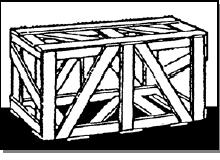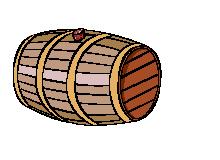
Home page||Ship employment
||
Types of packaging & stowage methods for break bulk cargo
Commodities shipped in general cargo ships
The exporter or seller is usually responsible for packing the goods for break bulk
cargo, whereby a consolidated consignment is broken down on delivery for
distribution to individual consignees. The type of packaging required for any product
varies with the nature and volume of the product as well as the method of transport it
is carried over. Generally the following types of packaging are used:
Bagged cargo
The commodity itself has to be robust to withstand outside
pressure and compression, for the bags will only hold the
contents in one place and will not provide protection against
external damage. Such commodities might typically be
fertilizers, grain (rice, maize, wheat, etc.), seeds, dried fruit,
sugar, coconut, coffee, fresh vegetables, frozen offal (meat
from carcasses), flour, copra, small items such as shells, raisins, etc., mail, salt, mineral
sands and ores, meal (fish, seed, copra, etc.), dried blood, dried milk etc..
Fibreboard boxes and cartons
Fibreboard boxes and cartons are very widely used
for the sake of economy and efficiency. Although
comparatively cheap, they are able to withstand
normal transport hazards and protect the contents
against loss or damage. They may be particularly
suitable in the case of goods carried in containers
from the point of origin to the destination provided
the goods are not fragile. But if the containers have
to be unloaded at the port of discharge for further
transport to their final destination, they may have to be placed on pallets and securely
strapped in order to protect them from pilferage and damage. Depending upon the
nature of the commodities, cartons of the right type of suitable strength and sizes
should be used.
Wooden cases
These have stood the test of time and their main
advantage is that they have the wall strength to support
superimposed loads. They are more expensive than the
carton-type packing due to the cost of wood. Wooden
cases are particularly suitable when the goods are
carried by conventional methods and, when they are
sensitive to heat, dampness, etc. The goods may
require protection by way of packing with layers of
insulating material, tar paper, sealed plastic covering
etc. There are different types of wooden cases,
including those made of plywood, which are being increasingly used by exporters.

Fig : Wooden crates
Wooden crates
These are suitable for wooden packages built like a
skeleton. The open crate can be used when the
contents are sufficiently resilient to require a
minimal form of packing to facilitate handling and
stowage. Sometimes, it is used as an outer package
to consolidate fibreboard boxes or give cartons extra
protection. The skeleton crate is often used for the
carriage of large pieces of machinery.
Bales
For certain trades, the use of hessian-wrapped bales is suitable, particularly when the
product permits pressure baling or compression by banding. It is, however, vulnerable
to pilferage, damage by handling using looks, etc..

Fig :Barrel
Drums, barrels, casks
These are generally used for liquids such as latex, chemicals,
whisky, detergents, oil, molasses, casings, paints, powders,
granules and other solids such as chemicals, cement, some
ores and scrap metal.
Shrink wrapping
Dry chemicals, granular and powdered substances in bags cannot be easily strapped
on to a pallet. When these items have to be unitised, bags are stowed on the pallet and
interlocked; a polythene sheet of suitable gauge is then draped over the bags. This unit
is then passed through a tunnel oven where polythene is heat-sealed tight, binding the
bags to the pallet to form a good unit load.
Lift vans
When household goods such as tables, chairs, cupboards, glassware, brassware, etc.,
have to be moved, especially from one country to another, they have to be packed in
"lift vans" which are unit loads specially built for the purpose. They are generally made
of wood, lined with waterproof material on all sides and additional metallic proofing
on the roof to prevent damage by rain and sun. These units are made to be handled
by forklift trucks and packed in ISO 20 foot containers.
Preservation against corrosion
Machinery when being packed for export by sea has to be preserved against humidity
and corrosion. All the open parts are chemically treated and sometimes greased. The
best preservation is to vacuum-seal the machine. The machine is covered by high
density polythene which is draped aver the unit and heat-sealed. A vacuum pump
then draws the air out of the polythene and the machine is preserved for as long as
one year under vacuum. In lift vans and other packaging, silica gel in sufficient
quantity is used, depending on the volume of the package.
Special cargo
There are also various other types of packages
designed for special commodities moving by
different forms of transport. For example, there are
special types of packages for air shipments of
commodities like fresh vegetables, meat etc. Again
the unit load device (ULD) system adopted for air
transport includes containers of metal and
fibre-glass as well as lightweight pallets.
In regard to
shipments of ready-made clothes, the latest
development, garments on hangers (GOH), is that
they are carried on hangers inside containers for delivery in the same condition as they
left to the consignees' premises or to the department stores at their destination.
Summarized below some more details on general cargo ship cargo handling procedure and operational info:
-
Cargo handling procedure for general cargo ship
Suitable safety nets or temporary fencing should be rigged where personnel have to walk or climb across built-up cargo, and are therefore at
risk of falling .
More .....
-
Various cargo handling techniques
(a) Technological advances in ship design and lifting equipment
(b) Rapid development and increase in the tonnages of bulk cargo
(c) The impact of unitisation, and
(d) The new and modern techniques of refrigeration, particularly with container
carriage.
More .....
-
Cargo information rules
The MS (Carriage of Cargoes) Regulations 1999 (SI 1999/336) [Regulation 4(1)] specifies that the shipper must provide such information to the operator or master sufficiently
in advance of loading to enable them to ensure that:
• the different commodities to be carried are compatible with each other or suitably separated;.
More .....
-
Cargo packaging - general cargo ships procedure
To achieve compatibility between cargo
owners and the owners of the means of
transport requires knowledge of the
cargo-handling procedures in transport.
These procedures are described with
reference to major characteristics of
commodities and cargoes. .
More .....
-
Cargo stowage plan
The copies are forwarded to agents at ports of
discharge to allow the booking and reservation of labour, as appropriate. Relevant details of cargoes, i.e. total quantity, description of package, bales, pallets etc., tonnage, port of discharge,
identification marks and special features if and when separated .
More .....
-
Shipment procedure for cargoes in different forms
General cargo is a term that covers a great variety of goods. In regard to modern
cargo handling it refers to loose cargo that has not been consolidated for handling
with mechanical means such as unitised or containerised cargo. It refers to individual
items of any type of cargo, bagged or baled items, cases or crates, individual drums or
barrels pieces of machinery or small items of steel construction. .
More .....
-
Information exchange on cargo stowage and planning
Advance planning, exchange of information, and continuous ship to shore communication are all critical. All cargoes should be stowed and secured in a manner that will avoid exposing the ship and persons on board to unnecessary risk.
More .....
-
Lifting and carriage of deck cargo
The safe securing of all deck cargoes should be checked by a
competent person before the vessel proceeds on passage. The master is
responsible for ensuring that it is correctly stowed and adequately secured
for the intended voyage. Areas on the deck which are not to be used for
cargo stowage should be clearly marked or otherwise indicated. .
More .....
-
Safe use of pesticides on board cargo ships
Ship's personnel should not handle fumigants and such operations
should be carried out only by qualified operators. Fumigation should only be
carried out with the agreement of the ship's master..
More .....
-
Types of packaging & stowage methods for break bulk cargo
The rigging time being negligible, and the crane is able to pick up and land permitted loads anywhere within its working radius. .
More .....
-
Various commodities carried by general cargo ships
Cargoes should be stowed and secured in a manner that will
avoid exposing the ship and persons on board to unnecessary risk. The safe
stowage and securing of cargo depends upon proper planning, execution
and supervision by properly qualified and experienced personnel. .
More .....
-
Methods of ventilation
The holds of most dry cargo ships are ventilated by a mechanical supply and natural exhaust system
.
More .....
-
Carriage of containers on cargo ships
The process of loading and securing
of goods into a container should follow the IMO/ILO/UN/ECE Guidelines
for Packing of Cargo Transport Units (CTUs). Special care should be taken
when lifting a container the centre of gravity of which is mobile, e.g. a tank
container, bulk container or a container with contents which are hanging..
More .....
-
Working in cargo spaces safely
Safety arrangements prior to working cargo should ensure that
adequate and suitable lifting plant is available, in accordance with the register
of lifting appliances and cargo gear, .
More .....
-
Cargo handling procedure for general cargo ship
Suitable safety nets or temporary fencing should be rigged where personnel have to walk or climb across built-up cargo, and are therefore at
risk of falling .
More .....
Machinery system main info pages
Home page||Cooling ||Machinery||Services ||Valves ||Pumps ||Auxiliary Power ||Propeller shaft ||Steering gears ||Ship stabilizers||Refrigeration||Air conditioning ||Deck machinery||Fire protection||Ship employment
||
Home ||
General Cargo Ship.com provide information on cargo ships various machinery systems -handling procedures, on board safety measures and some basic knowledge of cargo ships that might be useful for people working on board and those who working in the terminal. For any remarks please
Contact us
Copyright © 2010-2016 General Cargo Ship.com All rights reserved.
Terms and conditions of use
Read our privacy policy|| Home page||